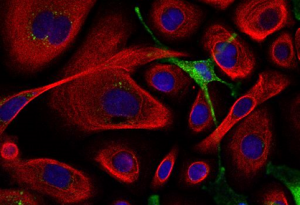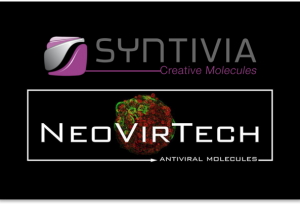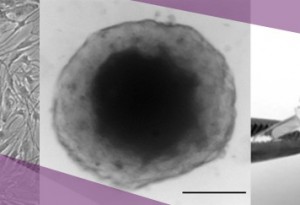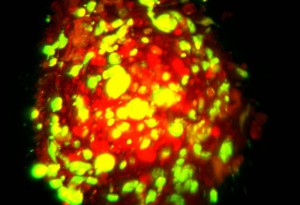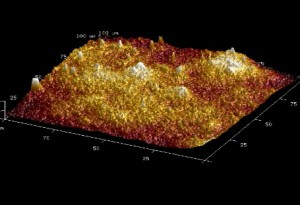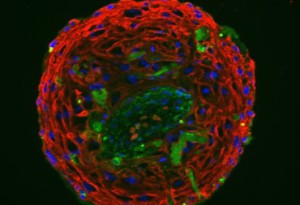In vitro tests
Skin pigmentation studies for cosmetics
Skin pigmentation is still a biological mechanism of interest in the cosmetic field. Whether it is to lighten the skin, provide a tanning effect or homogenize the complexion, brands and ingredient suppliers are constantly looking for ever more active products. Research on the mechanisms involved in skin pigmentation has made it possible to identify new […]
A collaboration for cosmetic ingredient screening
Syntivia and NeoVirTech announce a collaboration for high-content and high-quality cosmetic active ingredient screening. The synergy between knowledge in the dermo-cosmetic field and know-how in high content imaging paves the way for next generation screening for the discovery of tomorrow’s block buster products. NeoVirTech, an award winning innovative French company focusing its activity on antiviral […]
Greentech and Syntivia study the skin’s response to pollution
Greentech and Syntivia have recently joined forces in a co-authored study that uses the biological mechanisms implicated in the skin’s response to atmospheric pollution. The study highlights the biological activity of Greentech’s new anti-pollution product. Evaluating the skin’s response to pollution stress The aim of the study was to evaluate the potential anti-pollutant effect of an active extract of Shisandra […]
How to measure anti-pollution claims in vitro
In-Cosmetics Global, the leading event in the cosmetic industry, provides an excellent opportunity to suppliers of personal care ingredients to present their latest research and launch new active ingredients. As anti-pollution ingredients are a rising trend this year, Karl Lintner organized a workshop on “The pollution story: really a new trend?”. The workshop was dedicated to the […]
Cosmetogenomics for dermocosmetics
Last January, the European Center of Dermatology organized the 28th European Dermocosmetology Days in Lyon, France. The congress focused on personalized genomics and epigenetics as the future of dermocosmetics. Here at Syntivia, we frequently study gene regulation in the skin using a wide range of cosmetogenomics tests. This process helps us to better understand the activity of cosmetic […]
Syntivia combines transparent skin model and 3D skin imaging to study aging
Syntivia recently attended the Skin Physiology International Meeting in the Vichy Palais des Congrès (France) on November 17th and 18th, 2016 to present an innovative method to study effects on human skin. In a collaborative project with the Institute of Advanced Life Science Technology (ITAV) in Toulouse, Syntivia associates a transparent skin model and high-tech […]
New 3D skin model for cosmetic in vitro tests
The epidermal spheroid, a new 3D skin model As the cosmetic sector no longer allows the use of animal experiments to validate the effect of compounds, finding intermediate models between monolayer cell cultures and live human organisms has become a central issue. Marine Norlund, Biology Project Manager at Syntivia, has presented her work on a […]
New 3D skin model to study inflammatory response
SYNTIVIA uses a new 3D skin model, an epidermal spheroid, to evaluate cosmetic and dermatological ingredients. The epidermal spheroid is a unique and patented 3D model that contains the two major cell types of the epidermis, i.e. Normal Human Epidermal Keratinocytes (NHEK) and Normal Human Epidermal Melanocytes (NHEM). The epidermal spheroid faithfully reproduces the organization and functionality of […]
Atomic Force Microscopy to analyse nail polish
SYNTIVIA analyses nail polish using surface characterization based on Atomic Force Microscopy (AFM). Atomic Force Microscopes provide topography data (such as perceived roughness) and measure the nanomechanical properties of a surface (elasticity, stiffness, adherence). A nail polish containing a new active ingredient has been compared to a nail polish without the ingredient. The AFM analysis allowed to measure and illustrate […]
SYNTIVIA develops new epidermal spheroid skin model
Syntivia has developed a new epidermal spheroid skin model to test cosmetic and dermatological substances. The model comprises the two main cell types of the epidermis, i.e. Normal Human Epidermal Keratinocytes (NHEK) and Normal Human Epidermal Melanocytes (NHEM). Epidermal spheroids provide a more representative view of the human skin than 2D models, as they arrange the cells of the […]
HOW CAN WE HELP ?
DESIGN / DEVELOPMENT / EVALUATIONSYNTIVIA expertly guides your cosmetic product and project towards results.
Contact us

